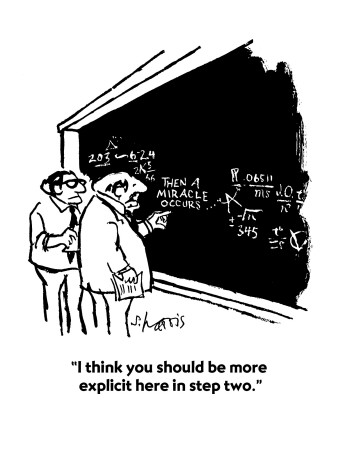
(image via The New Yorker Cartoon Bank)
The hardest arithmetic to master is that which enables us to count our blessings. ~Eric Hoffer, Reflections On The Human Condition
In my book, I write a story about a company that looked for an accountant. In the job interview, they just asked one question:
“How much is 1 + 1?”.
The first candidate said “Two!”.
The second candidate said “Three!”
The third asked “How much do you need?”
In the book, the story supports my description of how mortgages were done in “the good ole days”, when stated income was a norm.
Today this story comes to mind in a completely different context, though still connected to the past. Before choosing a loan, one has to ask themselves, “What do we need?” or what are our choices.
Before the end of 2008, when everything changed and property values dropped, it was very easy to get an equity line or a line of credit (L/C). Now, many borrowers who have first mortgages and L/Cs are facing a number of issues when trying to refinance their first mortgage for a lower rate.
If the combined balance between the two loans is less than the conforming limit of $417,000, the most common practice is to combine two loans together, since there is no increase in the interest rate. If there is enough equity, we can also apply for the subordination of the L/C, (i.e. borrowers will still have an L/C available to them without any current balance).
It becomes more challenging when the first mortgage or combined amount is higher than $417,000. Those loans have higher interest rates to start with, so when the first mortgage is combined with an L/C, it is considered cash-out refinancing; which results in a rate increase. Meanwhile, some lenders have adjustable programs that are fixed for 3, 5, 7, or 10 years, and offer excellent alternatives. You can see some of the options I presented to a client in a recent email:
“Dear Mark,
I reviewed your mortgage and here is my analysis; you have a number of alternatives:
You can refinance your first mortgage for $460,000 @3.625% at 30 years fixed with monthly payments of $2,097.84. Or 15 years fixed @ 3.0% with $3,176.00 in monthly payments. Both options are with no out of pocket closing costs. This is possible because lenders offer rebates. You can lower the rate by paying closing costs. Your credit line of $125,000 has to be subordinated, which we’ll do after your first mortgage is approved.
Consolidation of the first mortgage with the line of credit (L/C) will create a new loan of $585,000 which is considered a cash-out and therefore is priced at 4.25% 30 years fixed. At the same time, you can get $585,000.00 fixed for 7 years, and adjustable after that, at the rate 3.3% and monthly payments of $2,562.00. If you choose to pay more, as you are doing now, (I was basing on 15 years amortization with monthly payments $4,225.00), the balance of your loan after 7 years is going to be $347,684.00.”
No one knows what will happen in the next 7 years; however the interest rate on your L/C will probably go up. By paying down your new mortgage on the accelerated scale, you can bring the loan amount to the conforming limit, which has the lowest rate. You might have a concern that fixed rates will never be low again. And I agree – no one has a crystal ball. But I am an optimist; if it happened once, why would it not happen again?
P.S. And Men, don’t forget about your Wive’s intuition…
During our initial conversation with Mark, he claimed that his wife wanted a 30 year fixed rate while he preferred a 15 year. Shortly after my email, Mark and his wife, Joan called me, and we discussed proposed options and it was Joan who had the last word.
Her response was very simple:
“We are not going to live in this house for another 7 years; I like the security of one loan with a low interest rate. Though we talked to other companies, I would like you to help us. You are the only one who gave us options.”
SHARE IT WITH A FRIEND.
